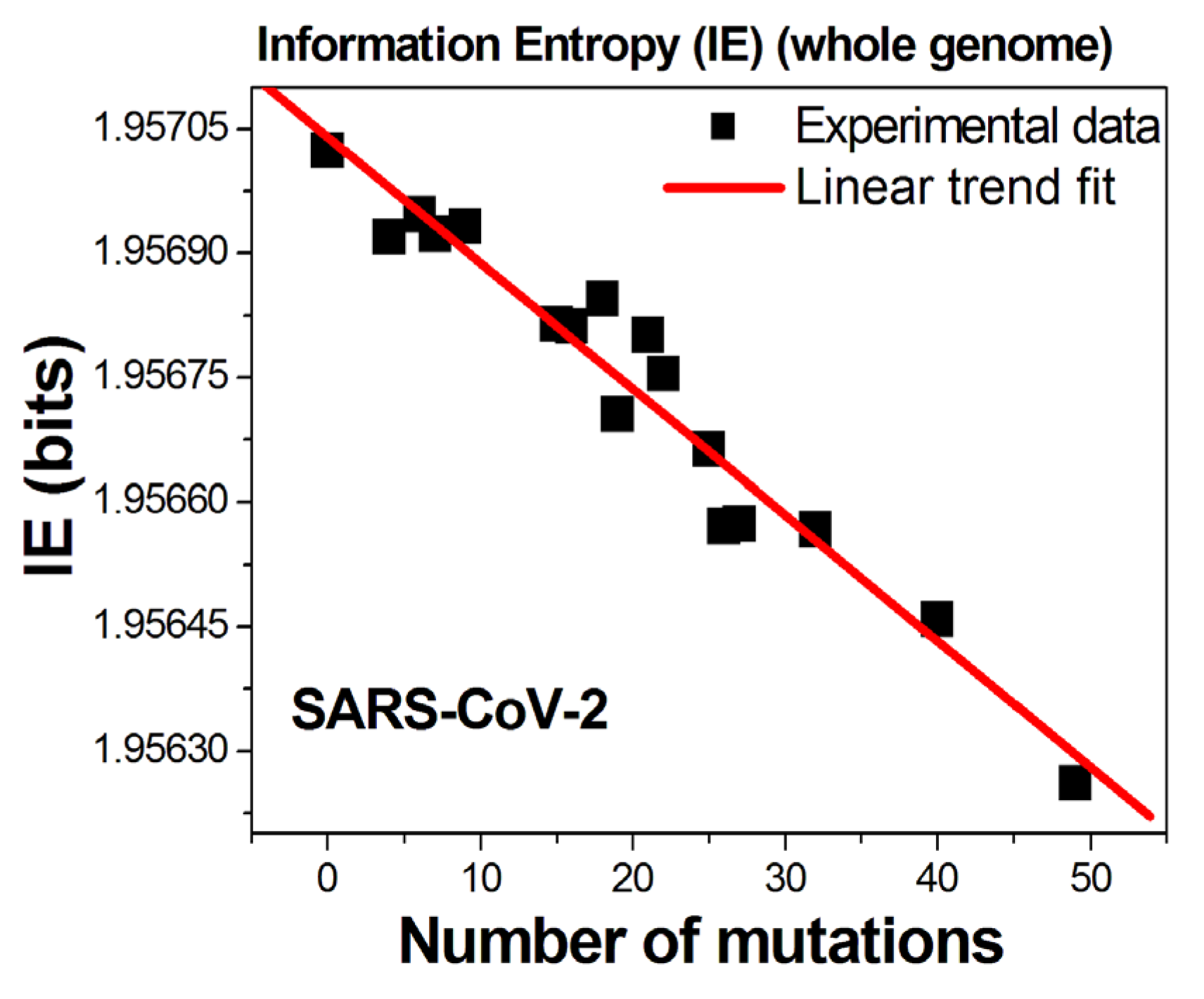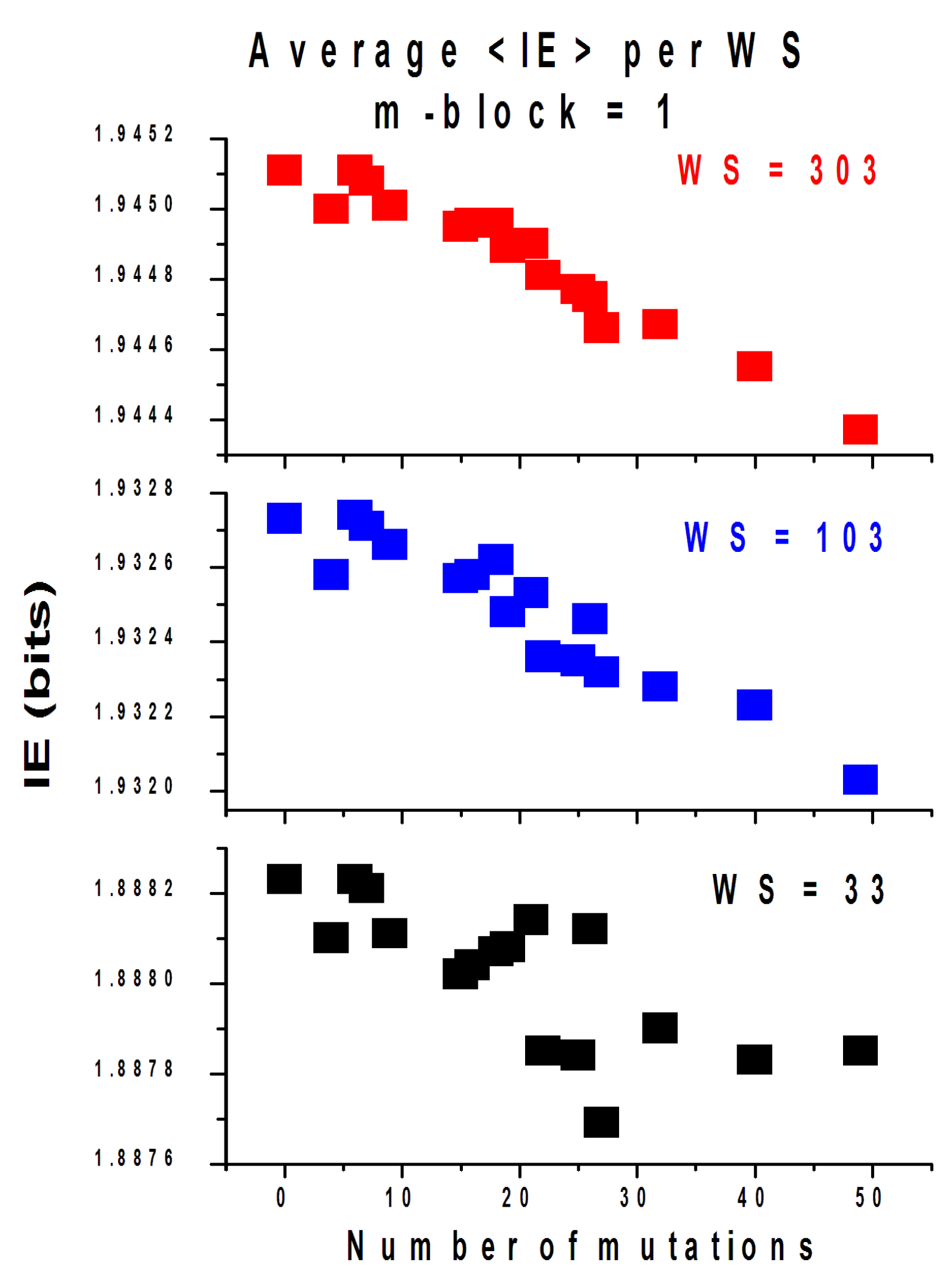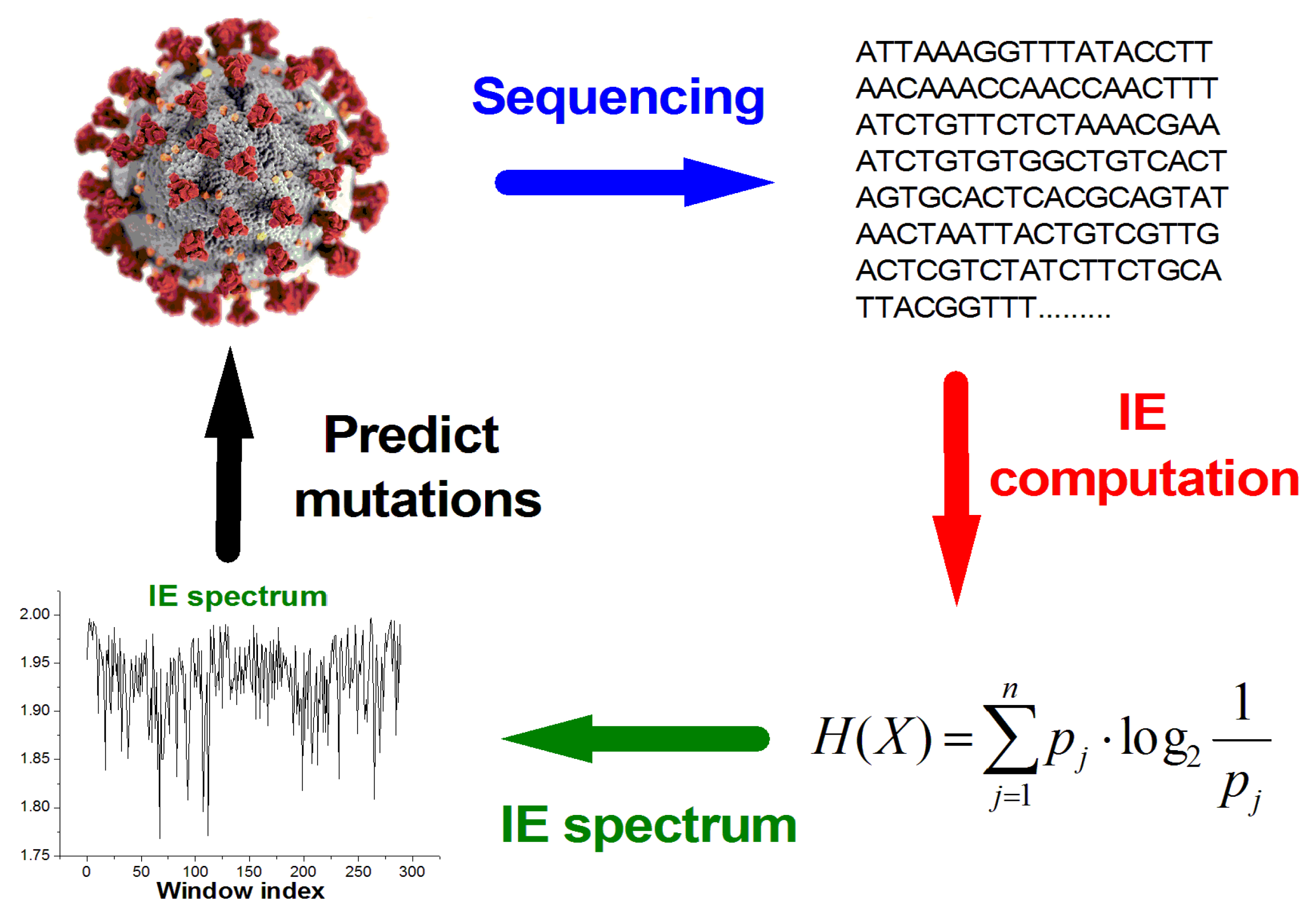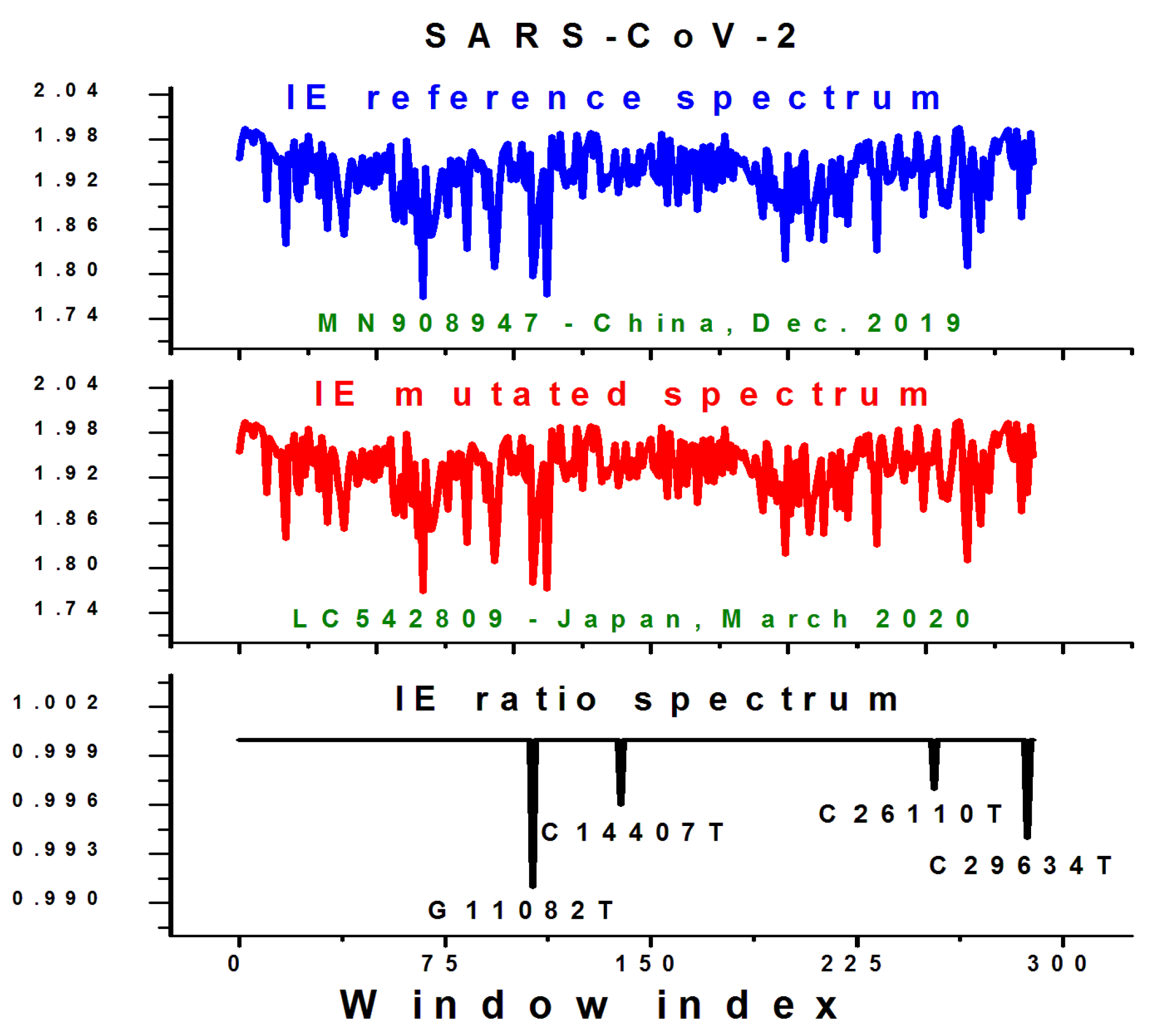A Possible Information Entropic Law of Genetic Mutations
Abstract
:Featured Application
Abstract
1. Introduction
2. Results
2.1. Information Theory Applied to Genomics
2.2. Information Entropy of SARS-CoV-2 Genomes
| Genome | Ref. | SNPs | Collection Time | Location | Shannon IE (Bits) |
|---|---|---|---|---|---|
| MN908947 | [7] | 0 | December 2019 | China | 1.9570243 |
| LC542809 | [10] | 4 | March 2020 | Japan | 1.9569197 |
| MT956916 | [11] | 6 | May 2020 | Spain | 1.9569468 |
| MT956915 | [12] | 7 | May 2020 | Spain | 1.9569230 |
| MW466798 | [13] | 9 | July 2020 | South Korea | 1.9569327 |
| OM098415 | [14] | 15 | May 2021 | China | 1.9568149 |
| OM098426 | [15] | 16 | May 2021 | China | 1.9568117 |
| MW679504 | [16] | 18 | February 2021 | USA | 1.9568451 |
| MW294011 | [17] | 19 | October 2020 | Ecuador | 1.9567058 |
| OK246811.1 | [18] | 21 | March 2021 | USA/PA | 1.9568012 |
| OK246805 | [19] | 22 | March 2021 | USA/PA | 1.9567543 |
| MW679505 | [20] | 25 | February 2021 | USA | 1.9566630 |
| MW735975 | [21] | 26 | February 2021 | USA/OH | 1.9565714 |
| MW695383 | [22] | 27 | December 2020 | USA/VA | 1.9865744 |
| OK546282.1 | [23] | 32 | April 2021 | USA/NE | 1.9565675 |
| OK104651.1 | [24] | 40 | August 2021 | Egypt | 1.9564591 |
| OL351371.1 | [25] | 49 | October 2021 | Egypt | 1.9562614 |
2.3. The Governing Entropic Law of Genetic Mutations
3. Predicting Mutations from Information Entropy Spectra
| Window Index | SNP | Reference Window (WS = 103) | IE Reference (Bits) | IE Mutated (Bits) |
|---|---|---|---|---|
| 108 | G11082T | CAATTTTGACTTCACTTTTAGTTTTAGT CCAGAGTACTCAATGGTCTTTGTTCTT TTTTTTGTATGAAAATGCCTTTTTACCT TTTGCTATGGGTATTATTGC | 1.796 | 1.779 |
| 140 | C14407T | CATACCACCCAAATTGTGTTAACTGTT TGGATGACAGATGCATTCTGCATTGTG CAAACTTTAATGTTTTATTCTCTACAGT GTTCCCACCTACAAGTTTTGG | 1.937 | 1.929 |
| 253 | C26110T | CTGGTGTTGAACATGTTACCTTCTTCAT CTACAATAAAATTGTTGATGAGCCTGA AGAACATGTCCAAATTCACACAATCGA CGGTTCATCCGGAGTTGTTAA | 1.963 | 1.956 |
| 287 | C29634T | GCTATATAAACGTTTTCGCTTTTCCGTT TACGATATATAGTCTACTCTTGTGCAGA ATGAATTCTCGTAACTACATAGCACAAG TAGATGTAGTTAACTTTAA | 1.909 | 1.898 |
4. Conclusions
Funding
Institutional Review Board Statement
Data Availability Statement
Acknowledgments
Conflicts of Interest
References
- Futuyma, D.J. Evolutionary Biology, 2nd ed.; Sinauer: Sunderland, MA, USA, 1986. [Google Scholar]
- Stern, D.L.; Orgogozo, V. The loci of evolution: How predictable is genetic evolution? Evolution 2008, 62, 2155–2177. [Google Scholar] [CrossRef] [PubMed] [Green Version]
- Monroe, J.; Srikant, T.; Carbonell-Bejerano, P.; Becker, C.; Lensink, M.; Exposito-Alonso, M.; Klein, M.; Hildebrandt, J.; Neumann, M.; Kliebenstein, D.; et al. Mutation bias reflects natural selection in Arabidopsis thaliana. Nature 2022, 602, 101–105. [Google Scholar] [CrossRef] [PubMed]
- Nei, M. The new mutation theory of phenotypic evolution. Proc. Natl. Acad. Sci. USA 2007, 104, 12235–12242. [Google Scholar] [CrossRef] [PubMed] [Green Version]
- Shannon, C.E. A mathematical theory of communication. Bell Syst. Tech. J. 1948, 27, 379–423. [Google Scholar] [CrossRef] [Green Version]
- Vopson, M.; Robson, S.C. A new method to study genome mutations using the information entropy. Phys. A Stat. Mech. Its Appl. 2021, 584, 126383. [Google Scholar] [CrossRef]
- Available online: https://www.ncbi.nlm.nih.gov/nuccore/MN908947 (accessed on 7 February 2022).
- GENIES Software Free Download. Available online: https://sourceforge.net/projects/information-entropy-spectrum/ (accessed on 12 December 2020).
- Genetic Information Entropy Spectrum (GENIES) User Manual. ResearchGate, 10 December 2020. Available online: https://www.researchgate.net/publication/346919613_Genetic_Information_Entropy_Spectrum_GNIES_User_manual (accessed on 12 December 2020).
- Available online: https://www.ncbi.nlm.nih.gov/nuccore/LC542809 (accessed on 7 February 2022).
- Available online: https://www.ncbi.nlm.nih.gov/nuccore/MT956916 (accessed on 7 February 2022).
- Available online: https://www.ncbi.nlm.nih.gov/nuccore/MT956915 (accessed on 7 February 2022).
- Available online: https://www.ncbi.nlm.nih.gov/nuccore/MW466798 (accessed on 7 February 2022).
- Available online: https://www.ncbi.nlm.nih.gov/nuccore/OM098415 (accessed on 7 February 2022).
- Available online: https://www.ncbi.nlm.nih.gov/nuccore/OM098426 (accessed on 7 February 2022).
- Available online: https://www.ncbi.nlm.nih.gov/nuccore/MW679504 (accessed on 7 February 2022).
- Available online: https://www.ncbi.nlm.nih.gov/nuccore/MW294011 (accessed on 7 February 2022).
- Available online: https://www.ncbi.nlm.nih.gov/nuccore/OK246811 (accessed on 7 February 2022).
- Available online: https://www.ncbi.nlm.nih.gov/nuccore/OK246805 (accessed on 7 February 2022).
- Available online: https://www.ncbi.nlm.nih.gov/nuccore/MW679505 (accessed on 7 February 2022).
- Available online: https://www.ncbi.nlm.nih.gov/nuccore/MW735975 (accessed on 7 February 2022).
- Available online: https://www.ncbi.nlm.nih.gov/nuccore/MW695383 (accessed on 7 February 2022).
- Available online: https://www.ncbi.nlm.nih.gov/nuccore/OK546282 (accessed on 7 February 2022).
- Available online: https://www.ncbi.nlm.nih.gov/nuccore/OK104651 (accessed on 7 February 2022).
- Available online: https://www.ncbi.nlm.nih.gov/nuccore/OL351371 (accessed on 7 February 2022).
- Vopson, M.M.; Lepadatu, S. The second law of information dynamics. AIP Adv. 2022, 12, 7. [Google Scholar] [CrossRef]




Publisher’s Note: MDPI stays neutral with regard to jurisdictional claims in published maps and institutional affiliations. |
© 2022 by the author. Licensee MDPI, Basel, Switzerland. This article is an open access article distributed under the terms and conditions of the Creative Commons Attribution (CC BY) license (https://creativecommons.org/licenses/by/4.0/).
Share and Cite
Vopson, M.M. A Possible Information Entropic Law of Genetic Mutations. Appl. Sci. 2022, 12, 6912. https://doi.org/10.3390/app12146912
Vopson MM. A Possible Information Entropic Law of Genetic Mutations. Applied Sciences. 2022; 12(14):6912. https://doi.org/10.3390/app12146912
Chicago/Turabian StyleVopson, Melvin M. 2022. "A Possible Information Entropic Law of Genetic Mutations" Applied Sciences 12, no. 14: 6912. https://doi.org/10.3390/app12146912
APA StyleVopson, M. M. (2022). A Possible Information Entropic Law of Genetic Mutations. Applied Sciences, 12(14), 6912. https://doi.org/10.3390/app12146912






